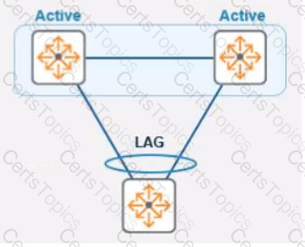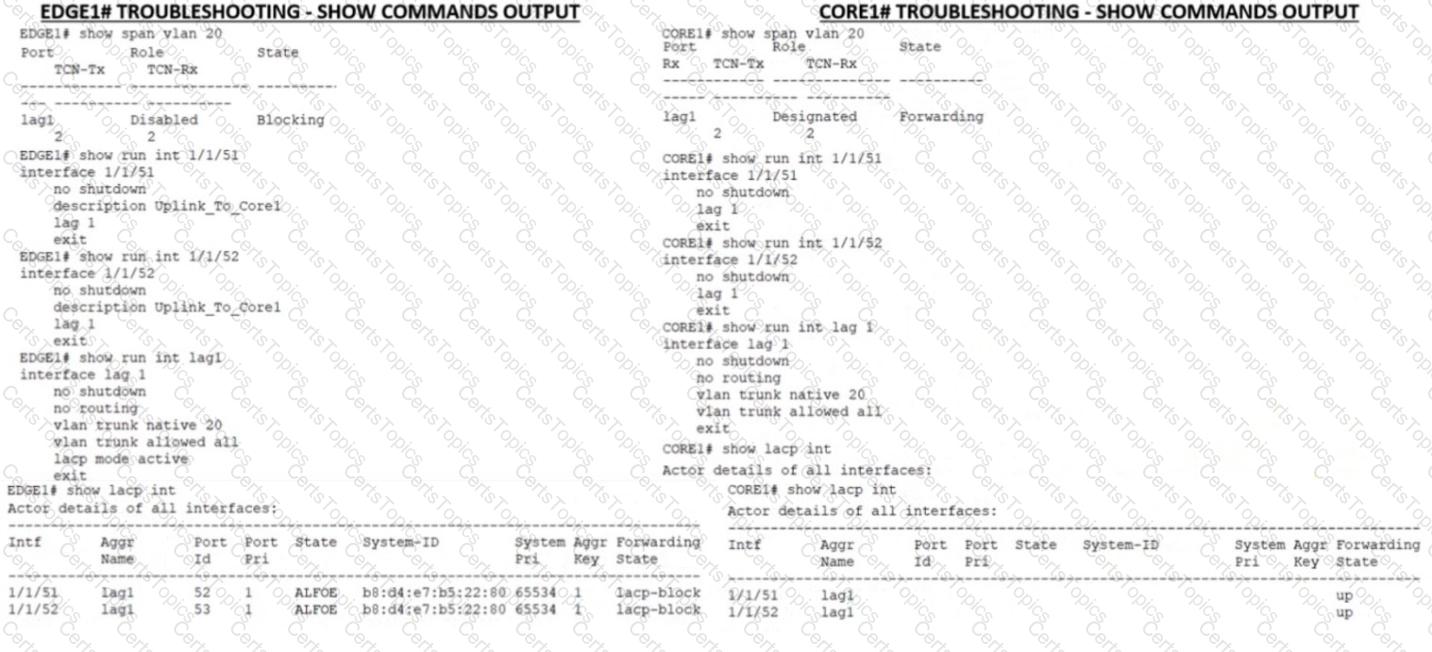
Based on the given topology, what is the requirement on an Aruba switch to enable LLDP messages to be received by Switch 1 port 1/1/24. when Router 1 is enabled with LLDP?
A network technician is verifying that a customer successfully connected to the guest network after completing the captive portal. The network technician looks at the access tracker in ClearPass.
Which role should be seen when looking at the OUTPUT tab for the customer's session?
What does a slow amber-flashing Stack-LED indicate?
Match the Aruba Central technology to the appropriate feature. (Matches may be used more than once.)

Which part of the WPA Key Hierarchy is used to encrypt and/or decrypt data''
When using Aruba Central what can identify recommended steps to resolve network health issues and allows you to share detailed information with support personnel?
Two independent ArubaOS-CX 6300 switches with Spanning Tree (STP) settings are interconnected with two cables between ports 1/1/1 and 1/1/2 All four ports have "no shutdown" and "no routing" commands
How will STP forward or discard traffic on these ports?
Match the most cost-effective option for cabling each requirement. (All lengths indicate total cable length including patch cable(s), service loops, etc. where used.)

Where are wireless client roaming decisions made?
You are in a meeting with a customer where you are asked to explain the network redundancy feature Multiple Spanning Tree (MSTP). What is the correct statement for this feature?
A hospital uses a lot of mobile equipment for the diagnosis and documentation of patient data What Is the ideal access switch for this large hospital with distribution racks of over 400 ports in a single VSF stack?
An AP signal strength of .0000001 milliwatts equals how many dBm?
What is the ideal Aruba access switch for a cost-effective connection to 200-380 clients, printers and APs per distribution rack?
The noise floor measures 000000001 milliwatts, and the receiver's signal strength is -65dBm. What is the Signal to Noise Ratio?
What is the recommended UXI monitoring solution in large logistic facilities?
What is the ideal mounting position for a typical Aruba indoor AP?
What is a common use of LLDP for wireless access points?
What is an advantage of using Layer 2 MAC authentication?
What happens when the signal from an AP weakens by being absorbed as it moves through an object?
Refer to the exhibit.

In the given topology, a pair of Aruba CX 8325 switches are in a VSX stack using the active gateway What is the nature and behavior of the Virtual IP for the VSX pair if clients are connected to the access switch using VSX as the default gateway?
Which authentication does Aruba's Captive Portal use?
What is the recommended VSF topology? (Select two.)
What is indicated by a flashing amber global status indicator LED on an Aruba CX6200M?
Which feature can network administrators use to centralized RF planning and optimization service when using an Aruba mobility master architecture?
You are configuring a network with a stacked pair of 6300M switches used for distribution and layer 3 services. You create a new VLAN for users that will be used on multiple access stacks of CX6200 switches connected downstream of the distribution stack You will be creating multiple VLANs/subnets similar to this will be utilized in multiple access stacks
What is the correct way to configure the routable interface for the subnet to be associated with this VLAN?
Which statement about manual switch provisioning with Aruba Central is correct?
You put in a few show commands on switches EDGE1 and CORE1 to attempt to gather information to troubleshoot the issue Use the show command output images to determine the reason for the EDGE1 uplink being down

Which statement is true for a device with a MAC address of B8-31-B5-80-41-4F?
You need to ensure that voice traffic sent through an ArubaOS-CX switch arrives with minimal latency. What is the best scheduling technology to use for this task?
Match the Open Systems Interconnection (OSI) layer with its comparable member of the TCP/IP stack. (Options may be used more than once.)